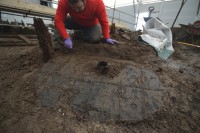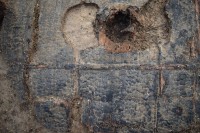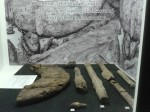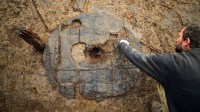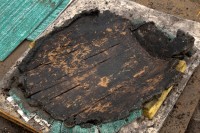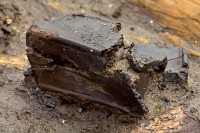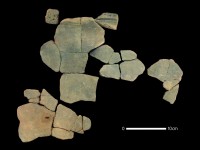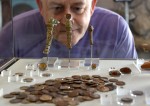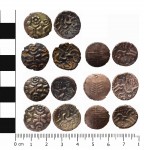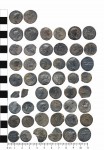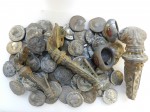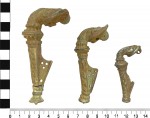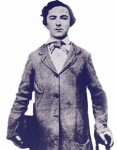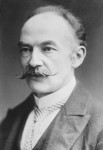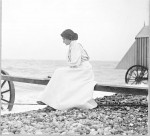![]() The 12th century Bogolyubskaya Icon of Theotokos (Greek for the Mother of God), once deemed an unfixable “archaeological ruin,” has been restored not quite to its original splendor but to its original colors. This is a great achievement for a revered artwork that is one of only about 30 icons from the 12th century that still survive. An exhibition at the Grabar Art Conservation Centre in Moscow tells the tale of its checkered life, from miraculous conception to this latest restoration.
The 12th century Bogolyubskaya Icon of Theotokos (Greek for the Mother of God), once deemed an unfixable “archaeological ruin,” has been restored not quite to its original splendor but to its original colors. This is a great achievement for a revered artwork that is one of only about 30 icons from the 12th century that still survive. An exhibition at the Grabar Art Conservation Centre in Moscow tells the tale of its checkered life, from miraculous conception to this latest restoration.
![]() The story begins in 1155 with Grand Prince Andrei Bogolyubsky (“Andrew the God-Loving”). He was traveling to the city of Vladimir, the new capital of the Vladimir-Suzdal Principality which arose from the demise of the Kievan Rus, a demise Andrei vigorously and successfully fought to accelerate. With him he carried a precious icon now known as the Miracle-Working Vladimir Icon of the Mother of God. The icon was Byzantine, made in Constantinople in 1131, but was believed to have been painted by Luke the Evangelist. It was also believed to have miraculous powers of protection, particularly in battle, which is why Andrei carried it with him.
The story begins in 1155 with Grand Prince Andrei Bogolyubsky (“Andrew the God-Loving”). He was traveling to the city of Vladimir, the new capital of the Vladimir-Suzdal Principality which arose from the demise of the Kievan Rus, a demise Andrei vigorously and successfully fought to accelerate. With him he carried a precious icon now known as the Miracle-Working Vladimir Icon of the Mother of God. The icon was Byzantine, made in Constantinople in 1131, but was believed to have been painted by Luke the Evangelist. It was also believed to have miraculous powers of protection, particularly in battle, which is why Andrei carried it with him.
Seven miles outside of the city near the banks of the Klyazma River, Andrei’s horses suddenly refused to take another step. The prince prayed before the icon the whole night and received a vision of the Virgin Mary holding a scroll in her right hand. She commanded him to take the icon to Vladimir and build a church and cloister on the place where she had appeared to him. Andrei did what she told him to and more besides, commissioning a new icon commemorating his holy vision.
 The icon depicted Mary holding a scroll in her right hand, just as Andrei has seen, her left hand raised in prayer to Jesus shown as an adult in the upper right hand corner. As promised, Prince Andrei built his own palace and a church, the Nativity of the Blessed Virgin, on the site of his vision. The icon was installed in the Convent of the Nativity of the Blessed Virgin (later known as the Bogolyubsky Convent). When another church in Vladimir, the Dormition or Holy Assumption Cathedral, was completed, the icon was translated to it.
The icon depicted Mary holding a scroll in her right hand, just as Andrei has seen, her left hand raised in prayer to Jesus shown as an adult in the upper right hand corner. As promised, Prince Andrei built his own palace and a church, the Nativity of the Blessed Virgin, on the site of his vision. The icon was installed in the Convent of the Nativity of the Blessed Virgin (later known as the Bogolyubsky Convent). When another church in Vladimir, the Dormition or Holy Assumption Cathedral, was completed, the icon was translated to it.
Under Andrey Bogolyubsky, Vladimir grew into the dominant cultural, economic and political center of the region and remained so until 1237 when it was besieged by the Mongol Golden Horde commanded by its founder Batu Khan. It fell on February 8th, 1238, and never again regained the prosperity and power it had once enjoyed. Dozens of Vladimir’s characteristic white limestone churches and public buildings were burned, but the icon survived the Mongol onslaught.
It nonetheless suffered many slings and arrows over the centuries. In 1722 the church building collapsed and the Bogolyubskaya Icon was trapped under the rubble for days. In 1771, Vladimir was struck by plague. The icon was paraded through the city and the epidemic miraculously ended. Every year after that the icon was brought to the city from May 21st until July 16th during which the miraculous procession was repeated in towns and villages all over the region.
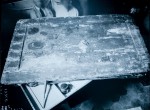 The annual parades almost destroyed the icon. Exposed to the elements, the centuries-old paint weakened and the wood panel deteriorated. After the revolution church art was nationalized by the Bolshevik government. A restoration commission headed by artist, art historian and founder of the conservation center that bears his name, Igor Grabar examined the icon. When they removed the metal casing, they were horrified to find the icon blackened, the paint crumbling, the gesso rotting, the panel bored with holes from wood worm and the surface crawling with live larvae. Dismayed restorer Alexander Anisimov called it an “archaeological ruin.” Thanks to Grabar’s judicious reluctance to interfere with what was left of the icon, a prescient approach that was not common then, the team documented it photographically, killed the pests and strengthened the board as best they could.
The annual parades almost destroyed the icon. Exposed to the elements, the centuries-old paint weakened and the wood panel deteriorated. After the revolution church art was nationalized by the Bolshevik government. A restoration commission headed by artist, art historian and founder of the conservation center that bears his name, Igor Grabar examined the icon. When they removed the metal casing, they were horrified to find the icon blackened, the paint crumbling, the gesso rotting, the panel bored with holes from wood worm and the surface crawling with live larvae. Dismayed restorer Alexander Anisimov called it an “archaeological ruin.” Thanks to Grabar’s judicious reluctance to interfere with what was left of the icon, a prescient approach that was not common then, the team documented it photographically, killed the pests and strengthened the board as best they could.
![]() Later restorers were not so circumspect. In a 1946 attempt to restore the icon, or at least prevent further deterioration, Vladimir museum restorer and artist F.A. Modorov came up with the idea of covering the surface with hot paraffin wax. He thought this would strengthen and protect the flaking paint layer. Who could have predicted that pouring hot wax on a delicate, wood worm-tunneled, flaking, 700-year-old painting would be hugely destructive? (Anyone. Anyone could have predicted that.) Subsequent attempts at restoration were able to better reveal Mary’s face and some of her clothes. They could not repair the decay of the gesso layer and the paint, but the icon was stable and under the constant supervision of conservators.
Later restorers were not so circumspect. In a 1946 attempt to restore the icon, or at least prevent further deterioration, Vladimir museum restorer and artist F.A. Modorov came up with the idea of covering the surface with hot paraffin wax. He thought this would strengthen and protect the flaking paint layer. Who could have predicted that pouring hot wax on a delicate, wood worm-tunneled, flaking, 700-year-old painting would be hugely destructive? (Anyone. Anyone could have predicted that.) Subsequent attempts at restoration were able to better reveal Mary’s face and some of her clothes. They could not repair the decay of the gesso layer and the paint, but the icon was stable and under the constant supervision of conservators.
![]() With the revival of the Russian Orthodox Church after the fall of the Soviet Union, the Cathedral of the Holy Assumption Convent in Vladimir claimed the icon. It was transferred to the convent in 1993 where it was put on display in a climate-controlled, hermetically sealed encasement made by the same outfit that made Lenin’s glass coffin. Lenin still looks great, but his encasement is constantly monitored and repaired. The icon received no such attention. Of the four batteries that powered the microclimate, only two of them worked and one of them had been sold by the nuns to raise money for the church, so really it was just a clear box with a lock. Meanwhile pilgrims left fresh flowers in vases of water at the feet of the icon, releasing humidity right into the box. On top of that, the original white limestone floor was replaced when a sponsor offered to install a new granite floor. Enter groundwater penetration, drainage problems, and perpetual damp. When one of the tiles was lifted later, mushrooms were growing underneath it.
With the revival of the Russian Orthodox Church after the fall of the Soviet Union, the Cathedral of the Holy Assumption Convent in Vladimir claimed the icon. It was transferred to the convent in 1993 where it was put on display in a climate-controlled, hermetically sealed encasement made by the same outfit that made Lenin’s glass coffin. Lenin still looks great, but his encasement is constantly monitored and repaired. The icon received no such attention. Of the four batteries that powered the microclimate, only two of them worked and one of them had been sold by the nuns to raise money for the church, so really it was just a clear box with a lock. Meanwhile pilgrims left fresh flowers in vases of water at the feet of the icon, releasing humidity right into the box. On top of that, the original white limestone floor was replaced when a sponsor offered to install a new granite floor. Enter groundwater penetration, drainage problems, and perpetual damp. When one of the tiles was lifted later, mushrooms were growing underneath it.
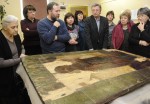 This disaster was discovered in 2009 when nuns reported there was some sort of fungus growing on the surface of the icon. The failure to properly care for one of the first icons ever painted in Russia and one of very few religious artifacts to survive the Mongol invasion caused a scandal. The Bogolyubskaya Icon was moved to the Vladimir-Suzdal Museum in Vladimir and a new program of restoration under Aleksandr Gormatyuk of the Grabar Art Conservation Centre began. Aided by the latest restoration technology — 3D scanning, CT scanning, scanning electron microscope examination, X-rays — Gormatyuk assessed the condition of the piece and traced the history writ on its paint. He identified no fewer than 20 interventions on the piece in its 858 years. The average for icons is 3 to 4 interventions.
This disaster was discovered in 2009 when nuns reported there was some sort of fungus growing on the surface of the icon. The failure to properly care for one of the first icons ever painted in Russia and one of very few religious artifacts to survive the Mongol invasion caused a scandal. The Bogolyubskaya Icon was moved to the Vladimir-Suzdal Museum in Vladimir and a new program of restoration under Aleksandr Gormatyuk of the Grabar Art Conservation Centre began. Aided by the latest restoration technology — 3D scanning, CT scanning, scanning electron microscope examination, X-rays — Gormatyuk assessed the condition of the piece and traced the history writ on its paint. He identified no fewer than 20 interventions on the piece in its 858 years. The average for icons is 3 to 4 interventions.
For six years Gormatyuk and his team worked to remove wax and resin layers and overpainting to reveal the original 12th century paint which by some miracle still survived. The Bogolyubskaya Icon now lives in a specially equipped restoration room with FUNCTIONING climate control systems. Only 12 people are allowed inside the room to eliminate human emissions and effluvia from the conservation equation as much as possible. The icon will be kept in the room and monitored for two more years at least.
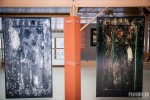 Since the icon is still far too fragile to travel, the Moscow exhibition uses life-sized photographs, orginal documents, weapons from the 12th century, white stone carvings from Vladimir to give visitors an understanding of the history of the Bogolyubskaya icon and its restoration. Friday, February 26th, is the last day of the exhibition, so if you’re in Moscow there is no time to waste.
Since the icon is still far too fragile to travel, the Moscow exhibition uses life-sized photographs, orginal documents, weapons from the 12th century, white stone carvings from Vladimir to give visitors an understanding of the history of the Bogolyubskaya icon and its restoration. Friday, February 26th, is the last day of the exhibition, so if you’re in Moscow there is no time to waste.
